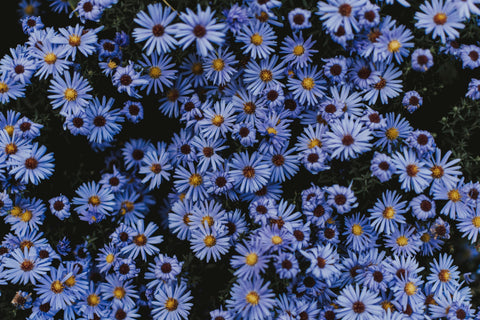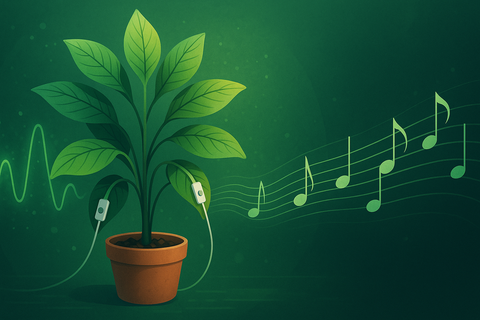August has this magical in-between vibe. Summer is still alive and golden, but you can feel fall sneaking in around the edges. The gardens, fields, and wild roadsides are popping with flowers that practically say, “Don’t forget about us before pumpkin spice takes over!”
This month, three blooms really steal the show: sunflowers, goldenrod, and asters. They’re not just gorgeous — they each carry a mood, a meaning, and an important role in keeping our ecosystems thriving. Let’s dive into their stories, their symbolism, and how you can grow them yourself.
![]()
Sunflowers (Helianthus annuus) are a symbol of summer itself. Their towering stalks and golden petals seem to radiate sunlight. They have a unique ability called heliotropism, which means young sunflower heads actually follow the path of the sun across the sky. It’s as if they are literally chasing light. Mature blooms eventually face east to welcome the rising sun every morning.
It’s no surprise sunflowers have come to symbolize loyalty, positivity, and hope. They remind us to look toward what nourishes us, even in times of change.

Sunflowers in Culture and History
In Native American traditions, sunflowers were grown as a food crop and medicine long before they became ornamental favorites. Their seeds were used for oil, dye, and healing salves.
Vincent van Gogh immortalized them in his famous “Sunflowers” paintings, using their bright yellow petals as a symbol of friendship and joy.
Today, sunflowers are the national flower of Ukraine, where they’ve taken on even deeper meaning as symbols of hope, peace, and resilience.

Ecological Importance
Sunflowers are ecological all-stars:
-
Their blooms are packed with nectar and pollen, making them irresistible to bees, butterflies, and other pollinators.
-
Their seeds provide rich nutrition for birds like goldfinches, sparrows, and even larger animals like squirrels.
-
Sunflowers also help clean contaminated soils by drawing out heavy metals in a process called phytoremediation.

Growing Tips
-
Plant sunflowers in full sun — at least 6–8 hours of direct light daily.
-
Sow seeds 1 inch deep in fertile, well-drained soil.
-
Space dwarf sunflowers about 6 inches apart, and give tall varieties at least 2–3 feet of room.
-
Water regularly at first, but once established, they tolerate dry conditions well.
-
Stake taller varieties to protect them from wind damage.

Goldenrod (Solidago spp.) is a native wildflower that bursts into bright yellow clouds just when most other flowers are starting to fade. Often mistaken for ragweed, it’s wrongly blamed for allergies. In reality, goldenrod’s pollen is heavy and sticky, carried by insects rather than the wind.
Goldenrod represents encouragement, good fortune, and resilience. Its sunny blossoms are like nature’s reminder that there is beauty in endings and strength in transitions.

Goldenrod in Culture and Folklore
In Victorian flower language, goldenrod was seen as a sign of encouragement and sometimes even luck in new ventures.
In herbal traditions, goldenrod has been used for centuries in teas and tinctures for its potential anti-inflammatory properties.
Garden designers love it for its striking contrast when paired with asters. Together, the golden yellow and deep purple create one of late summer’s most iconic color palettes.

Ecological Importance
Goldenrod is one of the most important late-season plants for pollinators:
-
Its nectar-rich flowers feed more than 100 species of insects, including bees, butterflies, and moths.
-
Monarch butterflies often stop at goldenrod on their long migration south.
-
Its hollow stems provide safe nesting and overwintering sites for native bees.
-
When paired with asters, goldenrod creates a “super magnet” effect, attracting more pollinators together than either plant can alone.

Growing Tips
-
Goldenrod thrives in poor or average soil, even where other flowers struggle.
-
Plant seeds in fall so they can germinate naturally in spring.
-
Once established, goldenrod is drought tolerant and hardy.
-
In small gardens, look for clumping varieties to avoid aggressive spreading.
-
Cut back after flowering if you want to keep it from self-seeding too much.

Just as summer begins to fade, asters arrive in a burst of color. Their name comes from the Greek word for “star,” and their dainty blooms in shades of purple, blue, pink, and white do look like tiny stars scattered across the garden.
Asters are rich in symbolism, standing for hope, patience, love, and new beginnings. They’re also September’s birth flower, making them a natural symbol of change and transition.

Asters in Culture and History
In Greek mythology, asters were said to have sprung from the tears of the goddess Astraea, who cried as she looked down on Earth’s dark night sky.
In Victorian times, asters symbolized charm and refinement, making them popular in bouquets.
Today, they’re beloved as the star of fall gardens, bringing a final wave of beauty before frost.

Ecological Importance
Asters are vital late-season nectar sources that carry pollinators into autumn:
-
Asters are one of the last nectar sources before winter, essential for late-season pollinators.
-
Monarch butterflies rely on asters during their migration journey.
-
Endangered bumblebee queens feed on asters to build up fat reserves for winter hibernation.
-
Their dense growth provides shelter for insects and small creatures as the weather cools.

Growing Tips
-
Plant asters in full to partial sun with well-drained, loamy soil.
-
Water at the base to keep leaves dry and prevent mildew.
-
Pinch back early in the summer to encourage bushier growth and more blooms.
-
Deadhead faded flowers to extend the blooming season.
-
Divide clumps every 2–3 years to keep plants healthy and vigorous.
-
Asters are frost-tolerant and will often bloom right up to the first hard freeze.

August is that sweet spot between summer and fall, and these flowers embody it perfectly. Sunflowers cheer us on with their sunny optimism. Goldenrod glows with encouragement and abundance. Asters sparkle like stars, reminding us that endings can be beautiful beginnings.
Whether you plant them in your backyard, admire them on a country roadside, or enjoy them as part of a bouquet, let them inspire you to stay grounded, embrace change, and always turn toward the light.
August bloomers are more than flowers. They are nature’s gentle reminder that every season has its own kind of magic.
![]()
![]()



